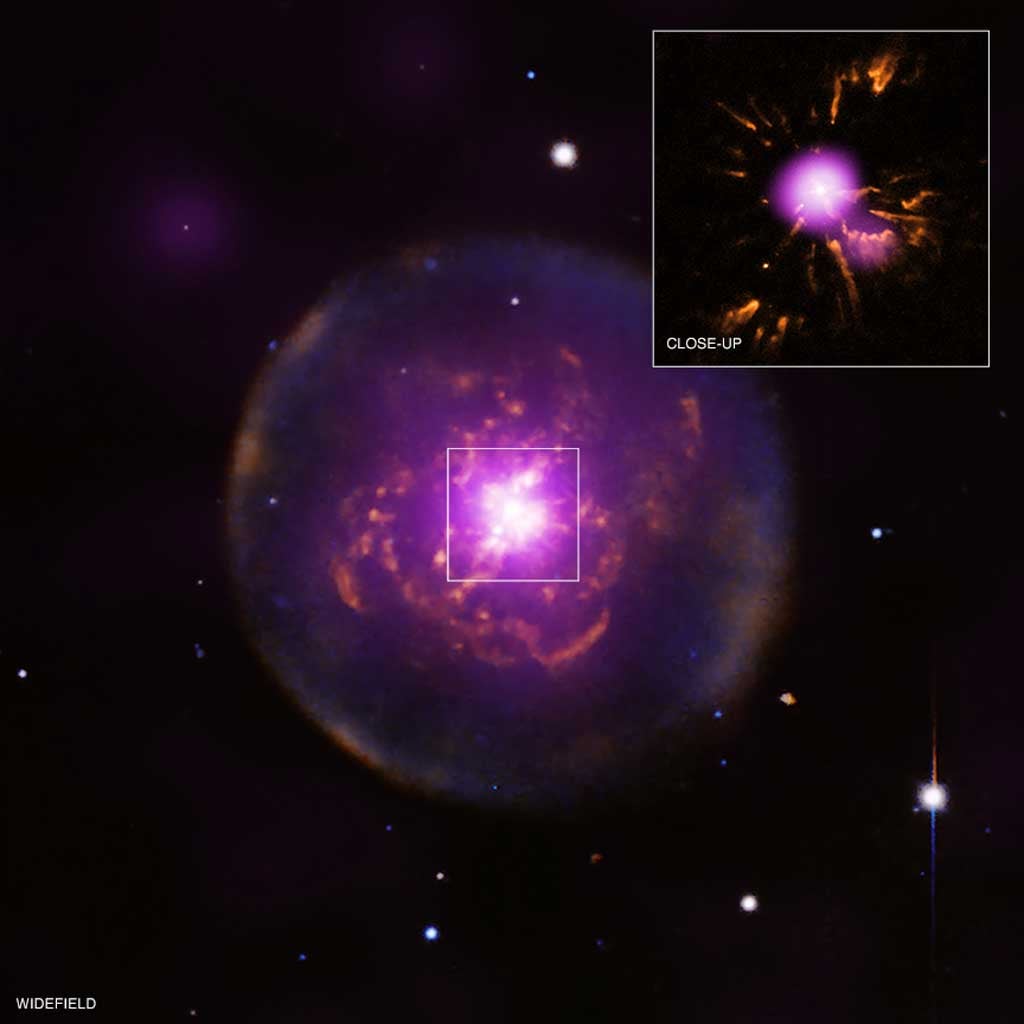Eventually the outer envelope of the red giant is ejected and moves away from the star at a relatively sedate speed of less than 100,000 mph (161,000 kilometers per hour). The star meanwhile transforms from a cool giant into a hot compact star that produces intense ultraviolet (UV) radiation and a fast wind of particles moving at about 6 million mph (10 million km/h). The interaction of the UV radiation and the fast wind with the ejected red giant envelope creates the planetary nebula, shown by the large spherical shell in the bigger image.
In rare cases, nuclear fusion reactions in the region surrounding the star’s core heat the outer envelope of the star so much that it temporarily becomes a red giant again. The sequence of events — envelope ejection followed by a fast stellar wind — is repeated on a much faster scale than before, and a small-scale planetary nebula is created inside the original one. In a sense, the planetary nebula is reborn.
The large nebula seen in the larger image has an observed age of about 12,500 years and was formed by the initial interaction of the fast and slow winds. The cloverleaf pattern of knots seen in both images corresponds to the recently ejected material. These knots were produced much more recently, as they have an observed age of about 850 years, based on observations of their expansion using the Hubble Space Telescope.
The diffuse X-ray emission seen in the larger image and in the region around the central source in the inset is caused by interactions between wind from the star and the knots of the ejected material. The knots are heated and eroded by this interaction, producing X-ray emission. The cause of the point-like X-ray emission from the central star is unknown.
Studies of A30 and other planetary nebulae help improve our understanding of the evolution of Sun-like stars as they near the end of their lifetimes. The X-ray emission reveals how the material lost by the stars at different evolutionary stages interact with each another. These observations of A30, located about 5,500 light-years away, provide a picture of the harsh environment that the solar system will evolve toward in several billion years when the Sun’s strong stellar wind and energetic radiation will blast those planets that survived the previous, red-giant phase of stellar evolution.
The structures seen in A30 originally inspired the idea of reborn planetary nebulae, and only three other examples of this phenomenon are known.
Eventually the outer envelope of the red giant is ejected and moves away from the star at a relatively sedate speed of less than 100,000 mph (161,000 kilometers per hour). The star meanwhile transforms from a cool giant into a hot compact star that produces intense ultraviolet (UV) radiation and a fast wind of particles moving at about 6 million mph (10 million km/h). The interaction of the UV radiation and the fast wind with the ejected red giant envelope creates the planetary nebula, shown by the large spherical shell in the bigger image.
In rare cases, nuclear fusion reactions in the region surrounding the star’s core heat the outer envelope of the star so much that it temporarily becomes a red giant again. The sequence of events — envelope ejection followed by a fast stellar wind — is repeated on a much faster scale than before, and a small-scale planetary nebula is created inside the original one. In a sense, the planetary nebula is reborn.
The large nebula seen in the larger image has an observed age of about 12,500 years and was formed by the initial interaction of the fast and slow winds. The cloverleaf pattern of knots seen in both images corresponds to the recently ejected material. These knots were produced much more recently, as they have an observed age of about 850 years, based on observations of their expansion using the Hubble Space Telescope.
The diffuse X-ray emission seen in the larger image and in the region around the central source in the inset is caused by interactions between wind from the star and the knots of the ejected material. The knots are heated and eroded by this interaction, producing X-ray emission. The cause of the point-like X-ray emission from the central star is unknown.
Studies of A30 and other planetary nebulae help improve our understanding of the evolution of Sun-like stars as they near the end of their lifetimes. The X-ray emission reveals how the material lost by the stars at different evolutionary stages interact with each another. These observations of A30, located about 5,500 light-years away, provide a picture of the harsh environment that the solar system will evolve toward in several billion years when the Sun’s strong stellar wind and energetic radiation will blast those planets that survived the previous, red-giant phase of stellar evolution.
The structures seen in A30 originally inspired the idea of reborn planetary nebulae, and only three other examples of this phenomenon are known.










